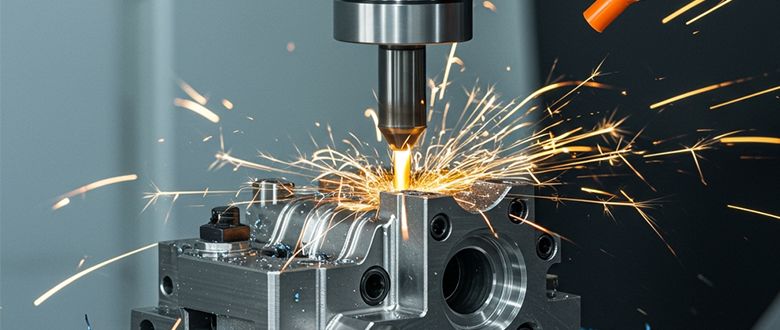High-Speed Machining is a advanced manufacturing process characterized by exceptionally high spindle speeds, feed rates, and relatively light depths of cut. It enables rapid material removal, superior surface finishes, extended tool life, and precise part production. HSM is crucial for achieving tighter tolerances, accelerating prototyping cycles, and boosting efficiency in mass production across various industries.
Are you facing challenges with lengthy lead times, compromised precision, or spiraling costs for complex components? Traditional machining methods can often be bottlenecks, slowing down your product development and hindering your market entry. The demand for intricate parts with tighter tolerances, delivered rapidly, is higher than ever.
This guide will introduce you to High-Speed Machining, a transformative approach that addresses these critical challenges. We will explore how HSM significantly accelerates both prototype development and large-scale production, ensuring unparalleled precision and efficiency. Discover how partnering with an expert like VMT, based in Shenzhen, can empower your projects with cutting-edge capabilities and reliable, swift delivery.
What is High-Speed Machining?
High-Speed Machining (HSM) is a revolutionary approach that transforms how parts are manufactured, especially those with complex geometries and stringent precision requirements. Unlike conventional machining, HSM leverages extremely high spindle speeds and feed rates, combined with small depths of cut, to remove material efficiently. This method ensures minimal heat buildup in the workpiece, leading to superior surface integrity and reduced distortion.
The core principles of HSM center on maintaining high dynamics in machine movement. This includes rapid acceleration and deceleration capabilities, alongside advanced control systems that ensure smooth, continuous tool paths. The outcome is not just faster production but also enhanced part quality and extended tool life. It represents a shift from brute force material removal to a more refined, precise, and controlled process.

The Advantages of High-Speed Machining
Embracing High-Speed Machining offers a multitude of advantages across various manufacturing stages. You will experience significant improvements in both your prototyping and full-scale production cycles. These benefits directly contribute to reduced operational costs and a stronger competitive edge in the market.
High-Speed Machining dramatically shortens lead times. Faster material removal rates mean your parts are completed quicker. Secondly, it elevates part quality, yielding smoother surfaces and tighter dimensional accuracies. This reduces the need for secondary finishing operations.
Furthermore, HSM extends tool life by minimizing cutting forces and heat. This translates to fewer tool changes and lower tooling costs. Finally, its ability to machine hardened materials effectively broadens your material options, streamlining processes that might otherwise require pre-machining and heat treatment.
Why High-Speed Machining is Crucial for Prototype Development?
In the fast-paced world of product innovation, speed and iterative refinement are paramount. High-Speed Machining provides an unparalleled advantage in the prototyping phase, allowing you to bring your concepts to life faster and validate designs more efficiently. This agile approach significantly reduces your time-to-market.
1. Accelerating Design Iterations
HSM’s rapid material removal capabilities mean that prototype parts can be manufactured in a fraction of the time compared to traditional methods. You can quickly test multiple design iterations, gather real-world feedback, and implement necessary adjustments. This iterative loop is crucial for optimizing functionality and manufacturability before committing to large-scale production.
With VMT, you can expect remarkably swift turnarounds. We offer standard part delivery in just 7 days, and even complex or non-standard components can be delivered within 25 days. For urgent needs, our express service ensures delivery in as little as 10 days, supporting your most critical deadlines.
2. Achieving Unmatched Precision in Prototypes
Even at the prototype stage, precision is non-negotiable, particularly for complex assemblies or miniature components. High-Speed Machining excels at producing parts with exceptional dimensional accuracy and intricate features. This allows for realistic testing and validation, identifying potential issues early on.

VMT guarantees consistent production stability with CNC tolerances of ±0.02mm and lathe tolerances of ±0.01mm. For your most demanding prototype requirements, we can achieve localized dimensional tolerances of ±0.005mm (5 microns) and form and position tolerances within 0.01mm. This level of precision ensures your prototypes accurately reflect final product quality.
3. Cost-Effectiveness for Small Batches
While HSM might seem like a premium service, its efficiency often translates to cost savings, even for small batch prototype runs. Reduced machining time, minimal rework, and the ability to use fewer tools contribute to a more economical overall process. You can obtain high-quality prototypes without incurring excessive expenses.
Our flexible approach includes no minimum order quantity (MOQ), allowing you to produce exactly the number of prototypes you need without unnecessary overhead. This provides significant flexibility for your development budget and project scope.
High-Speed Machining in Production: Scaling Efficiency and Quality
Beyond prototyping, High-Speed Machining proves its immense value in large-scale production environments. Its inherent efficiencies and quality control capabilities make it an indispensable tool for achieving high throughput, consistent product quality, and competitive manufacturing costs.
1. Maximizing Throughput and Production Capacity
For production runs, HSM translates directly into higher output. The accelerated material removal rates mean more parts are produced per hour, significantly increasing your overall production capacity. This scalability is vital for meeting market demand and fulfilling large orders efficiently.
2. Ensuring Consistent Quality Across Batches
Maintaining uniform quality across thousands or millions of parts is a critical challenge in mass production. HSM’s precise control over cutting parameters and reduced thermal effects lead to highly repeatable results. This minimizes variations between parts, ensuring every component meets your exact specifications.

Our comprehensive 12-step quality control process, from DFM review and IQC incoming material inspection to IPQC in-process checks and OQC final full inspection, is designed to ensure consistent, exceptional quality. We also conduct CPK capability verification on first articles to confirm process stability before production begins.
3. Reducing Post-Processing and Assembly Costs
The superior surface finish and dimensional accuracy achieved through HSM often eliminate the need for extensive secondary operations like grinding or polishing. This streamlines your post-processing pipeline, reduces labor costs, and accelerates the overall manufacturing cycle. More precise parts also lead to smoother assembly.
Key Technologies Driving High-Speed Machining Success
The effectiveness of High-Speed Machining is built upon a foundation of advanced technologies. Understanding these elements will help you appreciate the precision and efficiency HSM brings to your projects. These technological advancements ensure that complex designs can be translated into physical components with remarkable accuracy.
1. Advanced Machining Centers
At the heart of HSM are sophisticated machining centers equipped for high performance. These include machines with high-RPM spindles, robust structural rigidity to absorb vibrations, and rapid traverse rates. Multi-axis capabilities, particularly 5-axis machining centers, are crucial for complex geometries, allowing for continuous cutting and fewer setups.
VMT’s significant investment in over 55 CNC machining centers, including advanced 5-axis/3+2-axis simultaneous machines from leading brands like Fanuc, underscores our commitment to cutting-edge HSM. These machines are housed in a meticulously planned 5000 square meter factory, featuring dedicated constant-temperature precision machining zones.
2. Innovative Tooling and Tool Path Optimization
Specialized cutting tools are indispensable for HSM. These tools are designed with specific geometries and coatings that can withstand high speeds and temperatures while maintaining sharpness. Coupled with advanced CAM (Computer-Aided Manufacturing) software, tool paths are optimized to ensure smooth, continuous cutting, minimizing tool engagement time and maximizing material removal efficiency.
This synergistic combination of hardware and software allows for intricate detailing and complex contours to be machined with exceptional speed and precision. The intelligent management of tool paths reduces wear and tear, contributing to extended tool life and consistent part quality.
3. Precision Measurement and Quality Assurance
Achieving and maintaining high precision in HSM requires rigorous quality control throughout the manufacturing process. This involves using advanced metrology equipment to verify dimensions and geometric tolerances. Integrated quality systems ensure that every part conforms to specifications.
VMT implements a robust 12-step quality control system. This begins with Design for Manufacturability (DFM) analysis and continues through every stage: incoming material inspection (IQC), in-process quality control (IPQC) with first piece inspection and approval, pre-surface treatment inspection (FQC), and final full inspection before shipment (OQC). Our commitment extends to reliability testing (QA) and continuous improvement (QE), ensuring your parts meet the highest standards.
Comparative Advantage: High-Speed Machining vs. Traditional Methods
To fully appreciate the impact of High-Speed Machining, it’s beneficial to compare its characteristics against traditional machining methods. This comparison highlights why HSM has become the preferred choice for modern, high-demand manufacturing.
| Feature | Traditional Machining | High-Speed Machining (HSM) |
|---|---|---|
| Spindle Speed | Low to Moderate (e.g., < 10,000 RPM) | Very High (e.g., 20,000+ RPM) |
| Feed Rate | Moderate | Very High |
| Depth of Cut | Deep | Shallow |
| Material Removal Rate | Moderate | Very High |
| Surface Finish | Often requires secondary operations | Excellent, often no secondary finishing needed |
| Tool Life | Variable, depends on cutting conditions | Extended due to reduced heat/force |
| Heat Generation | High, can cause part distortion | Low, minimal thermal distortion |
| Material Capability | Good for softer metals | Excellent for hardened metals and alloys |
| Precision & Tolerance | Good, but limited by thermal effects | Superior (e.g., VMT: ±0.005mm localized) |
| Cost (Per Part, High Volume) | Higher due to longer cycle times/rework | Lower due to efficiency and reduced rework |
Choosing the Right Partner for Your High-Speed Machining Needs
Selecting a manufacturing partner is a critical decision that impacts your project’s success. For High-Speed Machining, you need a partner who possesses not only the advanced machinery but also the expertise, quality systems, and communication capabilities to deliver on your expectations.
Look for a partner with a proven track record in precision manufacturing. Ensure they have significant investment in cutting-edge HSM equipment and experienced personnel. A strong quality management system, transparent communication, and comprehensive value-added services like DFM consultation are also key indicators of a reliable partner.
VMT embodies these qualities. Our robust infrastructure, skilled team, and unwavering commitment to quality and efficiency make us an ideal choice. Located in Shenzhen, a hub of manufacturing innovation, we are strategically positioned to serve your global needs with competitive pricing and exceptional service.

In Conclusion
High-Speed Machining is no longer just a niche technique; it is a fundamental pillar of modern precision manufacturing. Its ability to drastically reduce lead times, elevate part quality, and optimize costs makes it indispensable for both rapid prototyping and efficient mass production. By harnessing HSM, you can accelerate your product development cycles, bring innovative designs to market faster, and maintain a competitive edge.
Partnering with a capable and experienced manufacturer like VMT ensures you fully leverage the power of High-Speed Machining. Our deep expertise, comprehensive suite of advanced equipment, stringent quality control, and agile delivery capabilities are dedicated to transforming your concepts into high-quality realities. Contact us today to discuss how our HSM solutions can propel your next project forward.
Frequently Asked Questions About High-Speed Machining
What types of materials are best suited for High-Speed Machining?
High-Speed Machining is highly effective for a wide range of materials, including aluminum alloys, stainless steel, titanium, various plastics, and even hardened steels. The specific parameters (spindle speed, feed rate, depth of cut) are optimized for each material to achieve the best results.
How does High-Speed Machining contribute to cost savings?
HSM contributes to cost savings by significantly reducing machining cycle times, extending tool life due to lower cutting forces and heat, and often eliminating the need for extensive secondary finishing operations because of superior surface finishes and precision.
Can High-Speed Machining accommodate complex part geometries?
Absolutely. HSM, especially when combined with multi-axis machining centers (like 5-axis machines), excels at producing highly complex geometries, intricate details, and deep cavities with excellent precision and surface quality, often in a single setup.
What is the typical lead time for parts manufactured using High-Speed Machining?
While specific lead times vary based on part complexity and material, High-Speed Machining inherently allows for much faster production. At VMT, we offer standard part delivery in 7 days, complex parts in 25 days, and urgent orders can be expedited to just 10 days.




